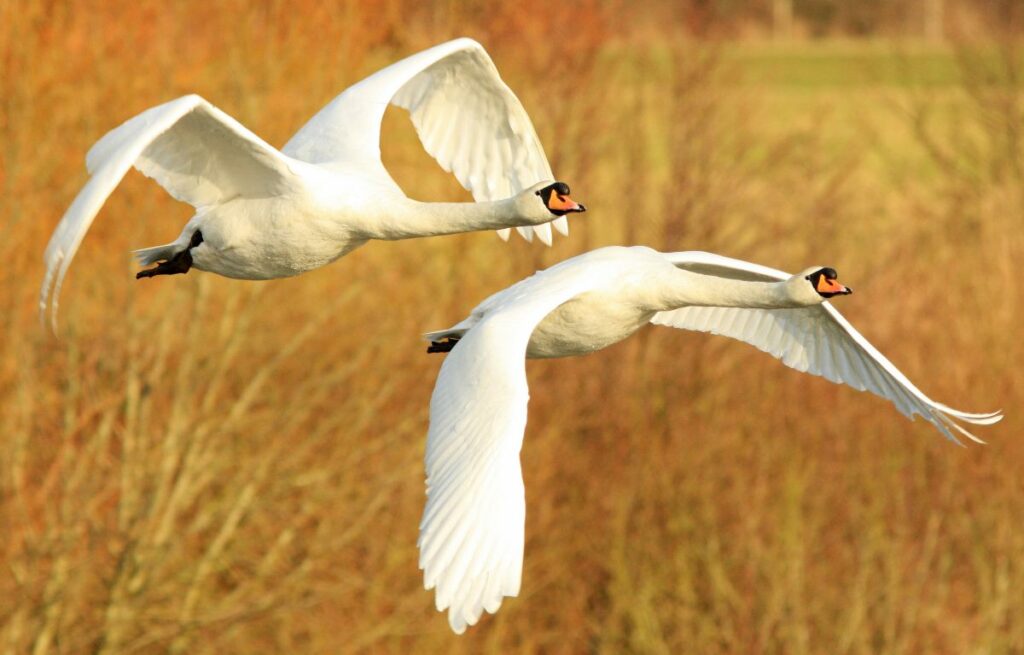Swans are large-bodied waterfowl that spend most of their lives gliding gracefully across the surfaces of lakes, ponds, rivers, and reservoirs. They are in North America, parts of South America, Europe, Australia, and Asia.
In addition to gracefully gliding across the water, swans fly in a distinctive pose with their long necks outstretched and large wings flapping slowly. One swan species, the Mute Swan, is the largest-bodied flying bird, averaging 50 pounds (23 kilograms).
Swan flocks often fly in formations, especially during long trips. These formations take the shape of a V or a diagonal line to allow them to conserve energy during flight and fly more efficiently. This flight pattern enables swans to fly further without needing frequent rest.

How Far Can Swans Fly?
Swans can fly long distances and do fly those distances seasonally. Some swan species can fly without stopping to rest for several hours in a day, covering hundreds or thousands of miles in one sustained flight.
A subspecies of the Tundra Swan, Bewick’s Swan, travels a whopping 4,000 miles (6,400 kilometers) twice each year between their summer residence in far northern Russia to their overwintering grounds in the United Kingdom.
Researchers sometimes track migrating swans by flying after them to find their preferred stopovers and identify their precise flight path. Scientists that use planes for tracking have to stop more frequently than the swans to refuel during a tracking session.
How High Can Swans Fly?
Swans are one of the highest-flying birds worldwide. Researchers often see them flying along their migration routes at around 6,000 to 8,000 feet (10,000 to 13,000 kilometers).
The Whooper Swan is one the highest flying birds worldwide, sometimes reaching altitudes of 29,000 feet (8,200 meters).
Birds that fly at high altitudes need specific adaptations that allow them to survive in a low-oxygen or hypoxic environment. Adaptations include larger hearts, higher ventilation rates, larger lungs with more capillaries, and increased oxygen extraction from the blood.
How Fast Can Swans Fly?
Swans fly at faster speeds than many other bird species. Their heavy bodies and immense wingspans make them powerful flyers that can reach speeds of 34 to 45 miles per hour (15 to 20 meters per second).
When Do Baby Swans Start Flying?
Pairs of male and female swans return to their summer nesting locations and start working to build a nest. They lay up to ten eggs in their nest between April and June. Young swans, often called cygnets, hatch out in the spring after five to six weeks of incubation.
These newly hatched cygnets leave the nest within a few days and start swimming with their parents, learning how to forage for food. They often stay with their parents for approximately six months before the parents stop caring for them and expect them to live on their own.
Before cygnets can fly, they must build strength in their chest muscles and develop their flight feathers. Cygnets make their first flight when they are around four months old, depending on the species.
Baby swans continue to develop and strengthen their muscles until they are ready to migrate at the beginning of winter. Once their parents cut off care, these juveniles often join the first flock they encounter and remain with them until reaching sexual maturity around age four.
Also Read: Can Flamingos Fly
Do Swans Migrate?
Swans migrate each year, flying from their summer nesting location to their overwintering residence at the beginning of winter and returning before spring. Many of these seasonal migrations require swans to travel thousands of miles.
During migration, swans can travel during the day and at night. During the day, they often travel at higher altitudes, allowing them to follow their flight path more easily. At night, swans typically fly closer to the ground.
Although many bird species use instincts to migrate, swans use visual cues learned from other swans. Swan flocks typically return to the same stopovers and follow the exact flight path between their summer nesting grounds and overwintering areas.
When a change in the landscape occurs, making a former stopover unusable, swans can choose a different place to rest. While this makes them flexible to a changing climate and human development, scientists and lawmakers continue to work together to protect this species.

Do swans soar, glide , fly without flapping their wings?